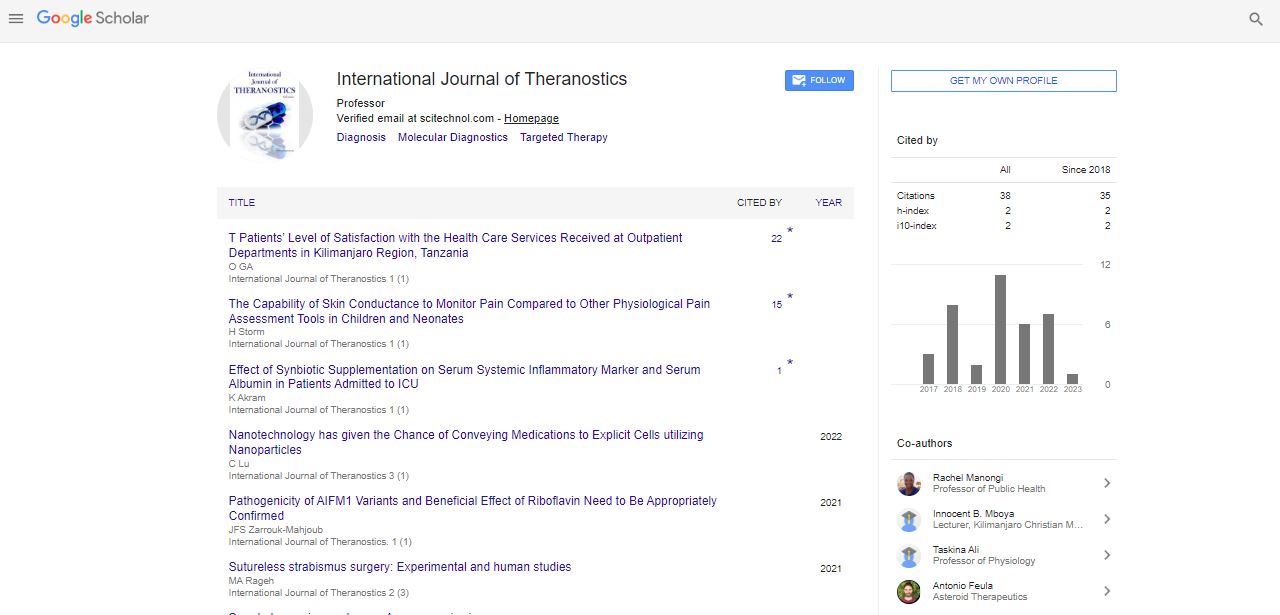Perspective, Int J Theranostic Vol: 12 Issue: 2
Nanotheranostics: Integrating Nanotechnology for Targeted Therapeutics and Molecular Imaging
Sears Arman*
1Department of Nanotheranostics, Stanford University, California, USA
*Corresponding Author: Sears Arman,
Department of Nanotheranostics, Stanford
University, California, USA
E-mail: Armanars22@hotmail.com
Received date: 29 May, 2023, Manuscript No. IJT-23-106972;
Editor assigned date: 31 May, 2023, PreQC No. IJT-23-106972 (PQ);
Reviewed date: 14 June, 2023, QCNo IJT-23-106972;
Revised date: 21 June, 2023, Manuscript No. IJT-23-106972 (R);
Published date: 30 June, 2023, DOI: 10.4172/IJT.1000129
Citation: Arman S (2023) Nanotheranostics: Integrating Nanotechnology for Targeted Therapeutics and Molecular Imaging. Int J Theranostic 12:2.
Description
Nanotheranostics, an innovative and rapidly evolving field, holds immense significant in modern medicine for its ability to combine therapeutic and diagnostic functionalities within a single nanoscale platform. This study provides a comprehensive review of nanotheranostics, exploring its principles, design strategies, applications, and future prospects. It delves into the integration of nanotechnology for targeted therapeutics and molecular imaging, highlighting the transformative potential of nanotheranostics in personalized medicine.
Nanotheranostics is an emerging field that brings together the realms of nanotechnology, therapeutics, and molecular imaging. By combining therapeutic agents and imaging agents within nanoscale carriers, nanotheranostics aims to revolutionize disease management through targeted treatment and real-time disease monitoring.
Principles of nanotheranostics
Nanomaterials for therapeutics: Various nanomaterials, such as liposomes, nanoparticles, dendrimers, and micelles, have unique properties that make them ideal carriers for therapeutic payloads, including drugs, nucleic acids, and peptides.
Imaging modalities: Nanotheranostics employs a range of imaging modalities, such as Magnetic Resonance Imaging (MRI), Positron Emission Tomography (PET), Computed Tomography (CT), and optical imaging, for precise disease visualization and monitoring.
Targeting strategies: Active and passive targeting strategies are employed to ensure specific accumulation of nanotheranostic agents at the disease site, thereby maximizing therapeutic efficacy and minimizing off-target effects.
Design and synthesis of nanotheranostic agents
Surface functionalization: Surface modifications of nanotheranostics play an important role in achieving targeted delivery and enhancing biocompatibility.
Encapsulation techniques: Various encapsulation methods are used to load therapeutic agents and imaging agents into the nanocarriers, maintaining their stability and releasing them in a controlled manner.
Multimodal nanotheranostics: The integration of multiple imaging and therapeutic modalities in a single nanoplatform enables multimodal imaging and combination therapy, leading to synergistic effects for enhanced treatment outcomes.
Applications of nanotheranostics
Cancer theranostics: Nanotheranostics have demonstrated remarkable success in cancer treatment by facilitating early tumor detection, targeted drug delivery, and real-time monitoring of treatment response.
Cardiovascular diseases: In cardiology, nanotheranostics has the potential to revolutionize disease management by enabling targeted drug delivery to atherosclerotic plaques and monitoring disease progression.
Neurological disorders: Nanotheranostics holds efficacy for early diagnosis and treatment of neurodegenerative diseases, with applications in targeted drug delivery across the blood-brain barrier.
Advantages and Challenges
Advantages of nanotheranostics:
• Enhanced therapeutic efficacy and reduced side effects through targeted drug delivery.
• Real-time disease monitoring and treatment response assessment.
• Multimodal capabilities for comprehensive disease characterization.
Challenges and limitations:
• Regulatory considerations and safety concerns related to nanomaterials.
• Scalability and cost-effectiveness of nanotheranostic agents.
• Translation of preclinical success to clinical applications.
Future perspectives
Personalized nanotheranostics: Advancements in nanotechnology and molecular diagnostics will pave the way for personalized nanotheranostics, tailoring treatments based on individual patient profiles.
Theranostic nanovaccines: Nanotheranostics can be harnessed to develop innovative nanovaccines for infectious diseases and cancer, providing targeted immune responses.
Smart nanotheranostics: The integration of stimuli-responsive nanotheranostics will enable on-demand drug release and imaging capabilities, further enhancing therapeutic outcomes.
Conclusion
Nanotheranostics represents a groundbreaking approach at the forefront of modern medicine, synergizing nanotechnology, therapeutics, and molecular imaging. With continuous research and collaboration, nanotheranostics holds the potential to transform disease management, providing personalized and precise treatments, and advancing patient care towards a more targeted and effective approach.
 Spanish
Spanish  Chinese
Chinese  Russian
Russian  German
German  French
French  Japanese
Japanese  Portuguese
Portuguese  Hindi
Hindi 